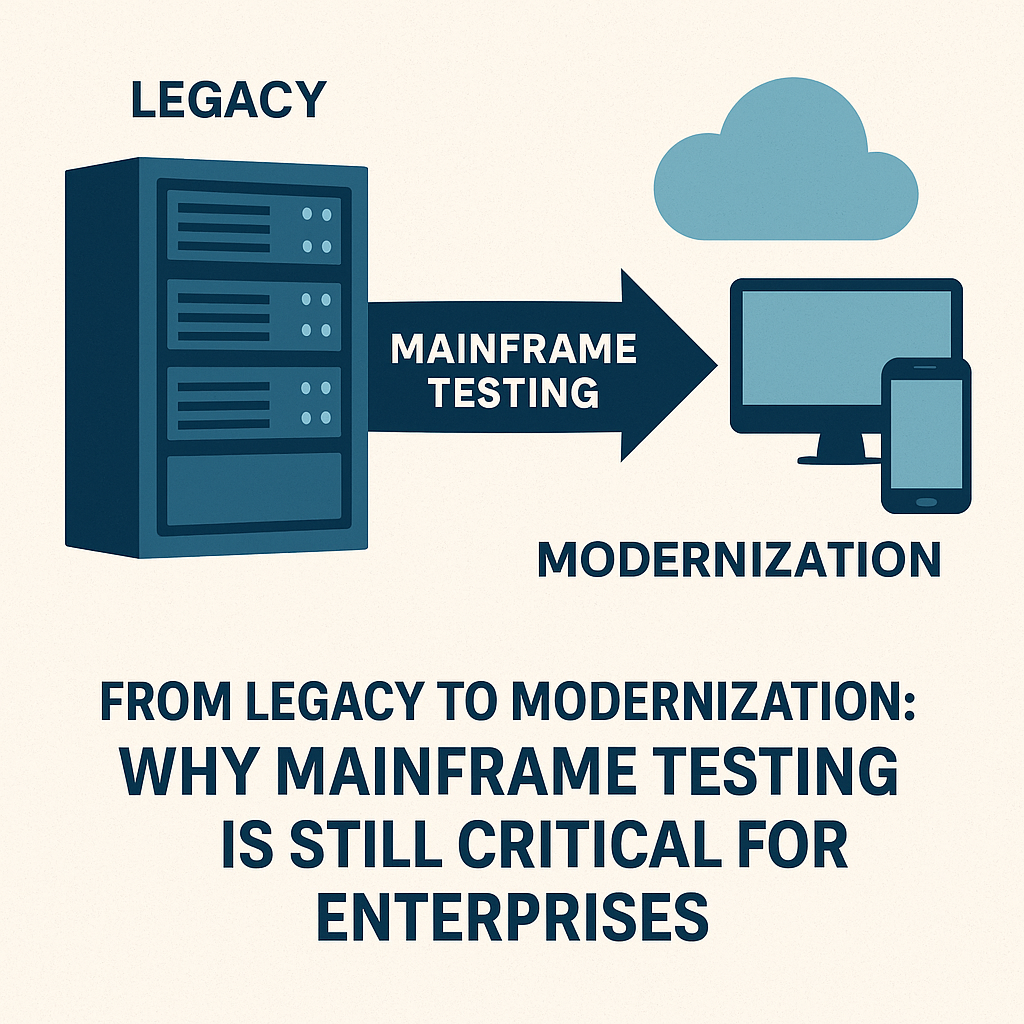
Introduction
Enterprises across industries; banking, healthcare, government, and insurance; continue to rely on mainframes as the backbone of mission-critical operations. Despite the growing shift toward cloud adoption, modern applications, and digital transformation, mainframes remain indispensable. They process vast amounts of data, support complex workflows, and deliver the reliability that enterprises have trusted for decades.
But modernization introduces a unique challenge: how do organizations ensure that these legacy systems can integrate seamlessly with modern platforms without sacrificing stability? The answer lies in robust, automated mainframe testing.
This article explores why mainframe testing remains essential during modernization initiatives and how adopting test automation solutions like testRigor to perform mainframe testing helps enterprises minimize risks while ensuring business continuity.
The Role of Mainframes in Modern Enterprises
Reliability and Scale
Mainframes are engineered for high-volume transactions and unmatched reliability. In industries where downtime translates into millions in losses or compliance breaches, mainframes deliver near-perfect uptime. Financial institutions, for example, depend on mainframes to process billions of transactions per day with precision and consistency. Airlines use them to manage bookings and flight operations worldwide. Retail giants rely on them for real-time inventory management and payment processing. Their capacity to handle scale without performance degradation makes them indispensable, even in a world dominated by cloud-native applications.
Security and Compliance
Mainframes have built-in features for encryption, auditing, and user authentication, which makes them essential in regulated industries. Enterprises cannot afford to compromise security during modernization efforts. In sectors like banking, insurance, and healthcare, strict compliance standards such as PCI DSS, HIPAA, and GDPR demand rigorous data protection. Mainframes not only enforce these requirements but also provide granular controls and audit trails that simplify compliance reporting. Their reputation for resilience against cyber threats has made them a cornerstone of secure enterprise IT infrastructure.
Integration with Modern Platforms
The modern enterprise often relies on hybrid IT environments. Mainframes need to coexist with APIs, cloud platforms, and distributed applications. This interdependence increases the need for testing strategies that validate end-to-end workflows across diverse ecosystems. For example, a transaction initiated in a mobile banking app often passes through cloud services before reaching a mainframe for final processing. Any failure along this chain could disrupt the customer experience. Ensuring seamless integration requires robust automated testing that verifies performance, security, and reliability across interconnected systems.
Why Modernization Demands Better Testing
Increased Complexity
When legacy systems are integrated with modern technologies, testing becomes exponentially more complex. Testing is no longer limited to COBOL programs or batch processes; it must also validate cross-system workflows, cloud-based applications, and APIs. This complexity is amplified in hybrid environments where data flows between mainframes, distributed systems, and mobile interfaces. Without robust testing, a small defect in one layer can ripple across the ecosystem, leading to costly disruptions. Enterprises therefore need test strategies that not only check isolated modules but also validate the entire business process from start to finish.
Speed of Innovation
Digital transformation initiatives aim to deliver value faster. However, manual testing cannot keep pace with agile development cycles. Automation is essential to ensure continuous testing and rapid release cycles without compromising quality. Modern DevOps pipelines rely on quick feedback loops, which are impossible to maintain through manual regression testing. Automated frameworks reduce cycle times, allowing QA teams to align with sprint goals while still ensuring high standards of reliability. In this way, testing transforms from a bottleneck into a driver of innovation.
Rising Expectations from Customers
Today’s users expect seamless digital experiences. Any downtime, transaction error, or performance lag could lead to customer dissatisfaction and reputational damage. Testing safeguards user trust. In industries like banking or retail, where customers interact with applications around the clock, even a brief outage can drive users to competitors. Automated testing ensures performance under peak loads, validates transactions end-to-end, and maintains compliance across regions. By proactively identifying issues before they reach production, enterprises can strengthen customer loyalty and uphold their brand reputation in a competitive digital marketplace.
The Shortcomings of Manual Mainframe Testing
Manual testing has been the default in many enterprises, but modernization has exposed its limitations:
- Time-Consuming: Regression cycles for mainframes often take weeks. This delays modernization initiatives. For example, every time a new integration is introduced; whether it’s an API, a mobile front end, or a middleware upgrade; manual testers must spend countless hours validating workflows. This creates bottlenecks in release cycles and slows the pace of digital transformation.
- Error-Prone: Human testers can miss critical edge cases in complex systems. With mainframes, the sheer volume of transactions, data sets, and dependencies makes it almost impossible to manually cover every scenario. A single overlooked defect in payroll processing, loan approvals, or insurance claims could lead to significant financial and reputational damage.
- High Cost: Skilled testers with mainframe expertise are scarce and expensive. As the workforce ages and fewer new professionals are trained in legacy systems, the cost of maintaining manual QA grows. Enterprises may need to retain niche talent or consultants, driving up operational expenses.
- Scalability Issues: Manual testing simply cannot keep pace with continuous integration and delivery pipelines. Modern DevOps practices demand rapid feedback loops, but manual processes slow this down. As enterprises scale their operations globally, relying on manual QA introduces inconsistencies that threaten overall system reliability.
The result? Enterprises risk delays, cost overruns, and vulnerabilities in mission-critical systems. In the long run, this reliance on manual testing not only hampers modernization but also jeopardizes an organization’s ability to remain competitive in fast-moving markets.
Automation as the Foundation of Modern Mainframe Testing
What Automation Brings
Automated mainframe testing introduces speed, accuracy, and repeatability to QA processes. Unlike manual testing, automation ensures consistency and enables continuous testing at scale. It allows enterprises to keep pace with the demands of agile development and DevOps practices, where rapid iterations are the norm.
Key benefits include:
- Faster regression testing to validate complex integrations
- Reduced human error in critical workflows
- Improved test coverage, including edge cases
- Better resource utilization by reducing reliance on niche mainframe skills
Beyond efficiency, automation also enhances collaboration across teams. Business analysts, developers, and QA professionals can share the same testing language, ensuring alignment on requirements and expected outcomes.
Why AI-Driven Testing Tools Lead the Way
Traditional automation frameworks often require coding expertise and struggle to scale across hybrid systems. By contrast, AI-driven testing tools like testRigor empower enterprises to automate test creation and execution in plain English, bridging the gap between business teams and QA engineers. This democratization of testing reduces technical barriers and accelerates adoption, making automation a strategic enabler of modernization.
Why Choose testRigor for Mainframe Testing
testRigor offers enterprises a modern approach to legacy testing challenges. Here’s why it stands out:
- No-Code Test Creation: Test scripts can be written in plain English, making them accessible to non-technical staff.
- End-to-End Coverage: testRigor validates workflows across mainframes, web apps, mobile apps, and APIs; ensuring seamless interoperability.
- Reduced Maintenance: Unlike brittle automation frameworks, testRigor minimizes test maintenance, which is especially valuable in complex mainframe environments.
- Scalability for Enterprises: Whether running thousands of transactions or integrating with cloud services, testRigor scales testing capacity to match enterprise demands.
While the benefits are compelling, enterprises often want a balanced view of new technologies. Below is a pros and cons comparison to help decision-makers evaluate fit:
| Pros of testRigor | Cons of testRigor |
| No-code test creation reduces reliance on technical specialists | May require initial investment in training for full adoption |
| Broad coverage across mainframe, web, mobile, and APIs | Some legacy testers may be resistant to moving away from manual processes |
| Minimizes test maintenance and reduces brittleness | Automation scope may need refinement for highly niche custom workflows |
| Scales easily for enterprise workloads | Enterprises must align automation strategy with governance policies |
Overall, the advantages far outweigh the limitations. By adopting testRigor, enterprises modernize testing without sacrificing control, security, or scalability; key priorities in any mainframe-driven environment.
Mainframe Testing in Digital Transformation Strategies
Supporting Continuous Delivery
Enterprises undergoing digital transformation need testing that aligns with DevOps and CI/CD pipelines. Automated testing enables continuous feedback loops, accelerating delivery cycles without introducing risk.
Reducing Modernization Risks
A poorly tested modernization effort can cause outages, financial losses, and compliance violations. Automation ensures that migration, integration, and system upgrades happen with minimal disruption.
Empowering QA Teams
With automation platforms, QA teams can focus on strategy and innovation rather than repetitive manual tasks. This shift increases productivity while ensuring better test quality.
The Future of Mainframe Testing
Mainframes are not disappearing anytime soon. In fact, modernization ensures they remain relevant in an increasingly digital landscape. Enterprises that fail to adopt automated testing risk falling behind competitors who can innovate faster and more securely.
Looking ahead, AI and no-code solutions will continue to transform mainframe testing, making it more accessible, scalable, and aligned with enterprise digital strategies.
If you’re exploring modernization initiatives, you might also find value in looking at these free AI testing tools that complement your QA strategy across different platforms.
Conclusion
Mainframes remain the heartbeat of enterprise IT. As organizations modernize, the risks associated with inadequate testing grow significantly. Manual testing can no longer meet the demands of speed, complexity, and reliability required by modern enterprises.
By embracing advanced automation through solutions like testRigor, enterprises can ensure that their mainframes remain reliable while integrating seamlessly into digital transformation initiatives.
Ultimately, mainframe testing is not a relic of the past; it is a critical enabler of the future.







